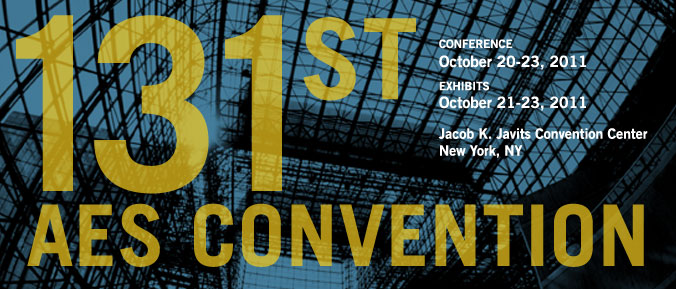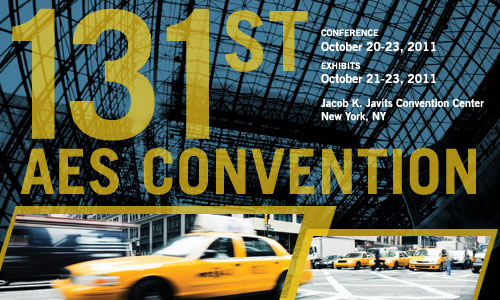
AES New York 2011
Poster Session P23
P23 - Spatial Audio Processing—Part 1
Sunday, October 23, 9:30 am — 11:00 am (Room: 1E Foyer)
P23-1 System Theory of Binaural Synthesis—Florian Völk, AG Technische Akustik, MMK, Technische Universität München - Munich, Germany
Binaural synthesis is widely used as an efficient tool for the simulation of acoustical environments. Different headphones together with artificial as well as human heads are employed for the transfer function measurements involved, having considerable influence on the synthesis quality. Within this paper, a detailed system theoretical analysis of the signal paths and systems involved in a typical data based binaural synthesis scenario is given. The components to be equalized are identified, and equalization methods for every scenario are discussed. Further, restrictions and necessities when using artificial or human recording heads and for headphone selection are given. Most important results are the necessity of blocked auditory canal measurements and the selection of proper headphones for completely correct individual binaural synthesis.
Convention Paper 8568 (Purchase now)
P23-2 A Quantization Method Based on Binaural Perceptual Characteristic for Interaural Level Difference—Heng Wang, Ruimin Hu, Weiping Tu, Xiaochen Wang, Wuhan University - Wuhan, Hubei, China
In this paper we study the mechanism exists of perceptual redundancy in spatial parameters and remove redundancy from energy domain to parameter domain. We establish a binaural perceptual model based on frequency dependent of Interaural Level Difference(ILD) and use this model to direct quantization of ILD. It solves the problem that the perceptual redundancy of spatial parameter is difficult to remove. The new quantization strategy merely quantizes the perceived variable quantity of ILD to reduce the coding bit rate. Experimental results showed that this method can bring down the parametric bit rate by about 15% compared with parametric stereo, while maintaining the subjective sound quality.
Convention Paper 8569 (Purchase now)
P23-3 Estimation of Head-Related Impulse Responses from Impulse Responses Acquired for Multiple Source Positions in Ordinary Sound Field—Shouichi Takane, Koji Abe, Kanji Watanabe, Sojun Sato, Akita Prefectural University - Akita, Japan
In this paper a new method for estimation of Head-Related Impulse Responses (HRIRs) from the impulse responses acquired in ordinary sound field is proposed. Estimation of a single HRIR from the impulse response in the same direction acquired in the ordinary sound field was proposed, and the estimation performance was shown to be not enough in some directions [S. Takane, 127th AES Convention, Paper No. 7885 (2009)]. In order to improve the estimation accuracy, the impulse responses acquired at multiple source positions are used, and the Auto Regressive (AR) coefficients of the HRIRs are assumed common for all source positions in the proposed method. The results of the example estimation of the HATS’ HRIRs showed that the estimation accuracy was significantly improved comparing with our previously proposed method.
Convention Paper 8570 (Purchase now)
P23-4 Toward the Creation of a Standardized HRTF Repository—Areti Andreopoulou, Agnieszka Roginska, New York University - New York, NY, USA
One of the main spatial audio topics, nowadays, involves working toward an efficient individualization method of Head Related Transfer Functions. A major limitation in this area of research is the lack of a large and uniform database that will incorporate as many individualized properties as possible. This paper presents the MARL-NYU file format for storing HRTF datasets, and investigates the necessary normalization steps that assure a uniform and standardized HRTF repository, by compiling selected datasets from four HRTF databases.
Convention Paper 8571 (Purchase now)
P23-5 On the Synthetic Binaural Signals of Moving Sources—Nara Hahn, Doo-Young Sung, Koeng-Mo Sung, Seoul National University - Seoul, Korea
Binaural signals of moving sources are synthesized using head-related impulse responses. The ear signals are synthesized such that the physical properties are correctly contained. The source signal at each time instance is filtered by the instantaneous head-related impulse response, and this wavelet is superimposed at the external ear. A number of properties of synthetic binaural signals are investigated. The spectral shift and head shadowing effect are analyzed in the time domain and in the time-frequency domain. The interpolation/extrapolation methods are employed to compute unmeasured head-related impulse responses. Artifacts caused by these processes are briefly reviewed.
Convention Paper 8572 (Purchase now)
P23-6 The Role of Head Related Transfer Functions' Spectral Features in Sound Source Localization in the Mid-Sagittal Plane—Daniela Toledo, COWI AS - Oslo, Norway
The individual nature of HRTFs is responsible for localization errors when non-individual HRTFs are used in binaural synthesis: localization performance is degraded if the spectral characteristics of the directional filters used do not match the individual characteristic of the listener's HRTFs. How similar the HRTFs should be to avoid degradation in the performance is still unknown. This investigation focuses on identifying and parameterizing spectral characteristics of HRTFs that are relevant as localization cues in the mid-sagittal plane. Results suggest that parameters computed from three spectral features of simplified versions of HRTFs help explaining sound source localization in that plane. Those parameters could be used for individualizing non-individual HRTFs.
Convention Paper 8573 (Purchase now)
Information Last Updated: 20111005, mei

